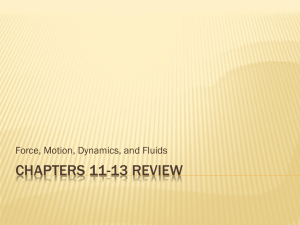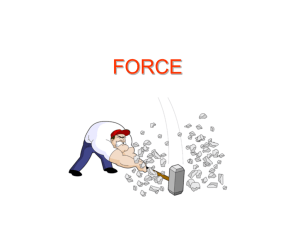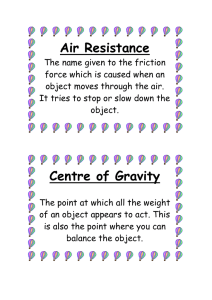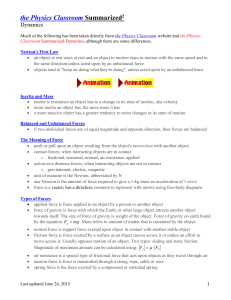Dynamics Packet 1 Name Period Date
advertisement
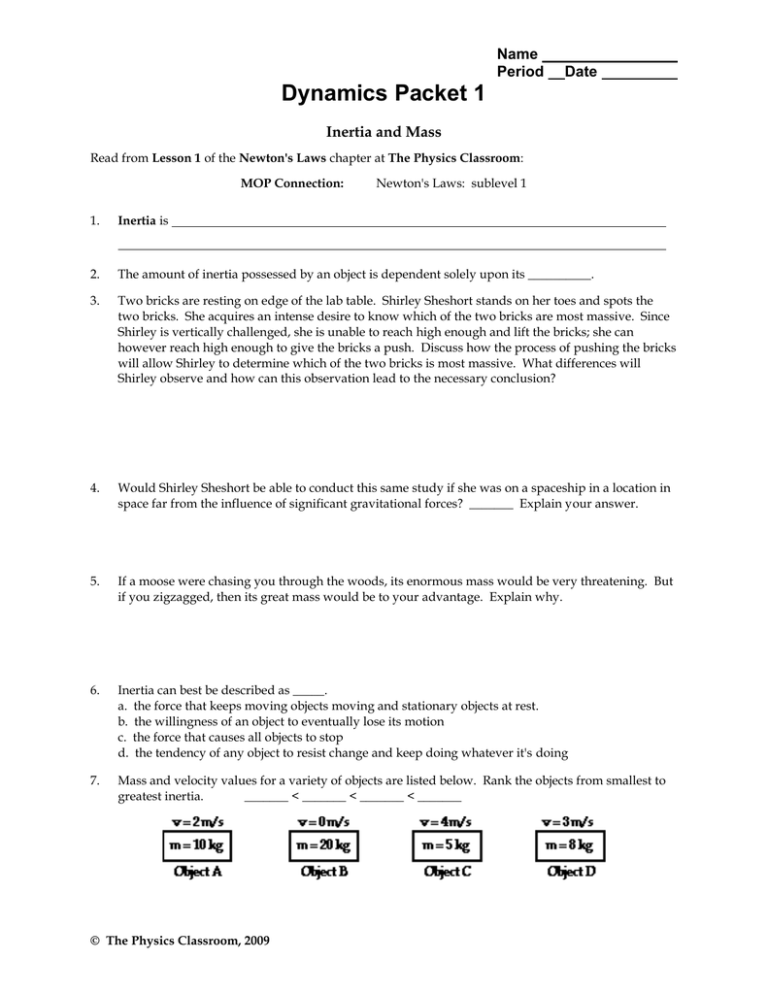
Name Period Date Dynamics Packet 1 Inertia and Mass Read from Lesson 1 of the Newton's Laws chapter at The Physics Classroom: MOP Connection: Newton's Laws: sublevel 1 1. Inertia is 2. The amount of inertia possessed by an object is dependent solely upon its __________. 3. Two bricks are resting on edge of the lab table. Shirley Sheshort stands on her toes and spots the two bricks. She acquires an intense desire to know which of the two bricks are most massive. Since Shirley is vertically challenged, she is unable to reach high enough and lift the bricks; she can however reach high enough to give the bricks a push. Discuss how the process of pushing the bricks will allow Shirley to determine which of the two bricks is most massive. What differences will Shirley observe and how can this observation lead to the necessary conclusion? 4. Would Shirley Sheshort be able to conduct this same study if she was on a spaceship in a location in space far from the influence of significant gravitational forces? _______ Explain your answer. 5. If a moose were chasing you through the woods, its enormous mass would be very threatening. But if you zigzagged, then its great mass would be to your advantage. Explain why. 6. Inertia can best be described as _____. a. the force that keeps moving objects moving and stationary objects at rest. b. the willingness of an object to eventually lose its motion c. the force that causes all objects to stop d. the tendency of any object to resist change and keep doing whatever it's doing 7. Mass and velocity values for a variety of objects are listed below. Rank the objects from smallest to greatest inertia. _______ < _______ < _______ < _______ © The Physics Classroom, 2009 Dynamics Packet 1 page 2 Pre-Conceptions Students typically have many pre-conceived notions regarding concepts in Physics. It has always proven useful to bring these ideas to the forefront of your mind and to make an effort to evaluate their correctness. The following statements pertain in one way or another to common notions regarding central concepts of this unit. Identify each statement as being either true (T) or false (F). Force and Motion - What Do You Believe? The following statements pertain in one way or another to common notions regarding force and motion. Identify each statement as being either true (T) or false (F). T or F? Statement 1. A force is required to keep an object moving in a given direction. 2. An upward moving object must be experiencing (or at least usually does experience) an upward force. 3. A rightward moving object must be experiencing (or at least usually does experience) a rightward force. 4. A ball is moving upwards and rightwards towards its peak. The ball experiences a force that is directed upwards and rightwards. 5. If a person throws a ball with his hand, then the force of the hand upon the ball is experienced by the ball for at least a little while after the ball leaves the hand. 6. A cannonball is shot from a cannon at a very high speed. The force of the explosion will be experienced by the cannonball for several seconds (or a least a little while). 7. If an object is at rest, then there are no forces acting upon the object. Mass and Weight - What Do You Believe? The following statements pertain in one way or another to common notions regarding mass and weight. Identify each statement as being either true (T) or false (F). T or F? Statement 1. Objects do NOT weigh anything when placed in a vacuum. 2. All objects weigh the same amount when placed in a vacuum, regardless of their mass. 3. An object weighs less on the moon than it does on the Earth. 4. The mass of an object on the moon is the same as its mass on the Earth. 5. A high-speed object (say, moving at 200 mi/hr) will weigh less than the same object when at rest. 6. A high-speed object (say, moving at 200 mi/hr) will possess measurably more mass than the same object when at rest. 7. Weight is measured in pounds; mass is measured in Newtons. 8. A free-falling object still has weight. 9. Weight is the result of air pressure exerted upon an object. © The Physics Classroom, 2009 Dynamics Packet 1 page 3 Balanced vs. Unbalanced Forces Read from Lesson 1 of the Newton's Laws chapter at The Physics Classroom: MOP Connection: Review: Newton's Laws: sublevels 2 and 3 An object at rest ... ; An object in motion .... ; unless ... . 1. The amount of force required to keep a 6-kg object moving with a constant velocity of 2 m/s is __ N. a. 0.333 b. 2 c. 3 d. 6 e. 12 f. ... nonsense! A force is NOT required to keep an object in motion. 2. Renatta Oyle is having car troubles. She is notorious for the trail of oil drops that she leaves on the streets of Glenview. Observe the following oil traces and indicate whether Renatta's car is being acted upon by an unbalanced force. Give a reason for your answers. Unbalanced Force? a. Yes or No Yes or No Yes or No Reason: b. Reason: c. Reason: 3. Each one of the dot diagrams in question #2 can be matched to a force diagram below. The force diagrams depict the individual forces acting upon the car by a vector arrow. The arrow direction represents the direction of the force. The arrow length represents the strength of the force. Match the dot diagrams from #2 to a force diagram; not every force diagram needs to be matched. Dot Diagram(s): _______ 4. Dot Diagram(s): _______ Dot Diagram(s): _______ If the net force acting upon an object is 0 N, then the object MUST ____. Circle one answer. a. be moving b. be accelerating c. be at rest d. be moving with a constant speed in the same direction e. either c or d. © The Physics Classroom, 2009 Dynamics Packet 1 5. 6. page 4 These graphs describe the motion of Carson Busses at various times during his trip to school. Indicate whether Carson's vehicle is being acted upon by an unbalanced force. Give a reason in terms of a description of what the car is doing (speeding up, slowing down, or constant velocity). Unbalanced Force? Yes or No? Unbalanced Force? Yes or No? Unbalanced Force? Yes or No? Reason/Description: Reason/Description: Reason/Description: A free-body diagrams show all the individual forces acting upon an object. The net force is the vector sum of all these forces (∑F). Determine the net force and state if there is an acceleration. a. ∑F = Accel'n? 7. b. ∑F = Yes or No Accel'n? c. ∑F = Yes or No Accel'n? Yes or No During an in-class discussion, Anna Litical suggests to her lab partner that the dot diagram for the motion of the object in #6b could be Anna's partner objects, arguing that the object in #6b could not have any horizontal motion if there are only vertical forces acting upon it. Who is right? ____________ Explain. 8. During an in-class discussion, Aaron Agin asserts that the object in #6a must be moving to the left since the only horizontal force acting upon it is a "left-ward" force. Is he right? ______ Explain. 9. The diagrams below depict the magnitude and direction of the individual forces acting upon an object. Which objects could be moving to the right? Circle all that apply. © The Physics Classroom, 2009 Dynamics Packet 1 page 5 Recognizing Forces Read from Lesson 2 of the Newton's Laws chapter at The Physics Classroom: MOP Connection: Newton's Laws: sublevel 4 There are several situations described below. For each situation, fill in the list provided by indicating which forces are present and stating which features of the situation you used to determine the presence or absence of the force. To facilitate this exercise, utilize the Net Force Help Sheet. Upon completion of this assignment, check your answers using the available Web page. http://www.physicsclassroom.com/morehelp/recforce/recforce.html Description of Situation 1. 2. A block hangs at rest from the ceiling by a piece of rope. Consider the forces acting on the block. A block hangs from the ceiling by a spring. Consider the forces acting on the block when it is at rest (at its equilibrium position). © The Physics Classroom, 2009 Force Present (P) or Absent (A)? Gravity P or A? Spring: P or A? Tension P or A? Normal: P or A? Friction P or A? Air Res.: P or A? Gravity P or A? Spring: P or A? Tension P or A? Normal: P or A? Friction P or A? Air Res.: P or A? Explanation Dynamics Packet 1 Description of Situation 3. 4. 5. A ball is shot into the air with a spring-loaded cannon. Consider the forces acting on the ball while it is in the air. A skydiver (who hasn't opened his parachute yet) falls at terminal velocity. Consider the forces acting on the skydiver. A block rests on top of a table. Consider only the forces acting upon the block. © The Physics Classroom, 2009 page 6 Force Present (P) or Absent (A)? Gravity P or A? Spring: P or A? Tension P or A? Normal: P or A? Friction P or A? Air Res.: P or A? Gravity P or A? Spring: P or A? Tension P or A? Normal: P or A? Friction P or A? Air Res.: P or A? Gravity P or A? Spring: P or A? Tension P or A? Normal: P or A? Friction P or A? Air Res.: P or A? Explanation Dynamics Packet 1 Description of Situation 6. 7. 8. A block is being pushed across the top of a table. Consider only the forces acting upon the block. A block slides across the top of a table. Consider only the forces acting upon the block. page 7 Force Present (P) or Absent (A)? Gravity P or A? Spring: P or A? Tension P or A? Normal: P or A? Friction P or A? Air Res.: P or A? Gravity P or A? Spring: P or A? Tension P or A? Normal: P or A? Friction P or A? Air Res.: P or A? Gravity P or A? Spring: P or A? The driver of a car has her foot on the gas pedal. Tension The wheels are turning as the car accelerates down Normal: the road. Consider only the forces acting upon the car. Friction Air Res.: © The Physics Classroom, 2009 P or A? P or A? P or A? P or A? Explanation Dynamics Packet 1 Description of Situation 9. A person is sitting on a sled and gliding across loosely packed snow along a horizontal surface. Consider only the forces acting on the person. page 8 Force Present (P) or Absent (A)? Gravity P or A? Spring: P or A? Tension P or A? Normal: P or A? Friction P or A? Air Res.: P or A? Gravity P or A? Spring: P or A? 10. The wheels of a car are Tension locked as it skids to a stop while moving across a level highway. Normal: Consider only the forces acting on the car. Friction 11. A bucket of water, attached by a rope, is being pulled out of a well. Consider only the forces acting on the bucket. © The Physics Classroom, 2009 P or A? P or A? P or A? Air Res.: P or A? Gravity P or A? Spring: P or A? Tension P or A? Normal: P or A? Friction P or A? Air Res.: P or A? Explanation Dynamics Packet 1 page 9 Mass and Weight Read from Lesson 2 of the Newton's Laws chapter at The Physics Classroom: MOP Connection: Newton's Laws: sublevel 6 1. The standard metric unit for mass is _____ and the standard metric unit for weight is _____. 2. An object's mass refers to _____ and an object's weight refers to _____. Fill in each blank. a. the amount of space it takes up b. the force of gravitational attraction to Earth c. how dense an object is d. the amount of stuff present in the object 3. Complete the following table showing the relationship between mass and weight. Object Mass Melon 1 kg Apple Pat Eatladee 4. Approx. Weight ~1.0 N 25 kg Different masses are hung on a spring scale calibrated in Newtons. The force exerted by gravity on 1 kg = ~10 N. The force exerted by gravity on 5 kg = ~______ N. The force exerted by gravity on 70 kg = ~________ N. 5. The value of g in the British system is 32 ft/sec2. The unit of force is pounds. The unit of mass is the slug. Use your weight in pounds to calculate your mass in units of slugs. PSYW 6. You might be wondering about your metric weight. Using conversion factors, convert your weight in pounds to units of N. (Use 1 N = 0.22 pounds) PSYW 7. What is the mass and weight of a 10-kg object on earth? Mass = Weight = What is the mass and weight of a 10-kg object on the moon where the force of gravity is 1/6-th that of the Earth's? Mass = Weight = 8. Conclusion: The _______________ of an object is independent of the object's location in space. © The Physics Classroom, 2009



